Talk to any experienced aquarist, and chances are they have had guppies in their tank at one time or another.
Poecilia reticulata is widespread in the wild, coming from rivers and lakes of South America and the mighty Amazon River.
There are over 300 beautiful color varieties of this easy-to-care-for fish. Aquarists love their lively and active nature combined with their graceful fins.

They also are small, have a low bioload, and do not need a ton of space to thrive.
Guppies are best kept in groups of three, keeping twice as many females as males if both sexes are in the same tank.
In this article
Guppy Compatibility Factors
Keep in mind the following when picking tank mates.
Water Parameters
They are a hardy species that tolerates a wide range of water parameters:
- Water temperature can range from 50 to 84°F/10-29°C (mid-70 range is best),
- pH level from 1 to 14 (6.8 to 7.8 is best),
- Hardness from 8 to 12 dGH,
- Guppies even thrive in brackish water!
This wide range allows the guppy to pair with many species.
Size
Your guppy will reach adult size between 2 to 2.5 inches long (5-6 cm).
They should be paired with similarly sized fish to avoid any bullying and to avoid your guppy being seen as food.
Temperament
Guppies are peaceful and social but not always found in a school. Larger groups allow the fish to be comfortable and more active.
Guppies are fast swimmers and tend to nip at the fins of slower-moving fish.
Recommended Tank Mates for Guppies
Below we touch on some of the many possible species with which your guppies can be paired.
1. Cardinal Tetras (Paracheirodon axelrodi)
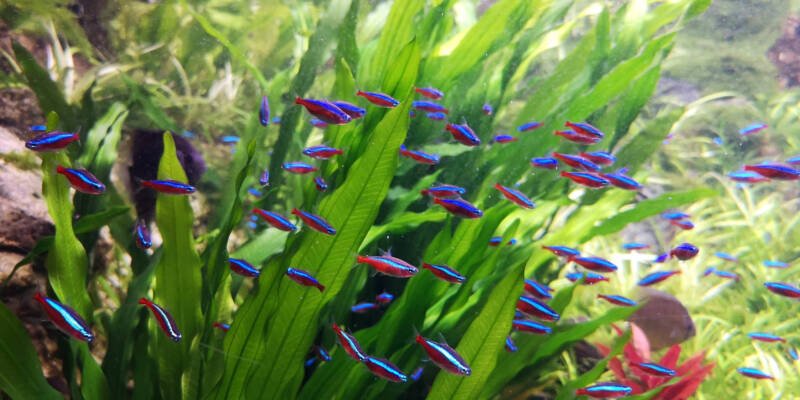
Minimum Tank Size: 20 gallons
The cardinal tetra is a dramatically colored, peaceful shoaling fish.
It does well in both large and small community tanks and reaches an adult length of 2 inches (5 cm).
Keep these fish in groups of at least six to show their best colors and behaviors.
They are not aggressive and make excellent guppy partners. Like your guppies, cardinals love a heavily planted tank.
While most of their water parameters match, the cardinal likes very soft water of 2 to 6 dKH, while the guppy prefers moderately hard water.
Make sure the tank is well cycled before adding your tetras.
2. Female Betta (Betta splendens)

Minimum Tank Size: 5 gallons for a single fish
Although male bettas are highly aggressive and territorial, the females are less so.
They are incredibly curious and seek their owner’s attention.
All water parameters for these two species match perfectly, and they love the same calm, well-planted waters.
Female bettas can be kept singly or in a group with peaceful shoaling species.
Adjust the tank size accordingly for each additional tank mate to reduce the chance of territorial aggression.
The betta’s adult size of 2.25 inches (5.7 cm) matches well with that of the guppy, and one is not likely to pick on the other.
3. Cory Catfish (Corydoras spp.)

Minimum Tank Size: 10 gallons
The cory catfish is highly recommended for most home aquariums.
They are any one of 165 unique species of armored catfish, which gives plenty of options.
Depending on the species, they reach a length of 1 to 4 inches (2.5-10 cm).
These peaceful bottom dwellers are slow swimmers that mind their own business, scooting along and looking for food.
They can occupy a tank as a single specimen; however, they are best in a group of four to six.
Water parameters match well with the guppy’s but check whether your fish was captive-bred or wild-caught as the pH requirements vary.
4. Dwarf Neon Rainbow Fish (Melanotaenia praecox)
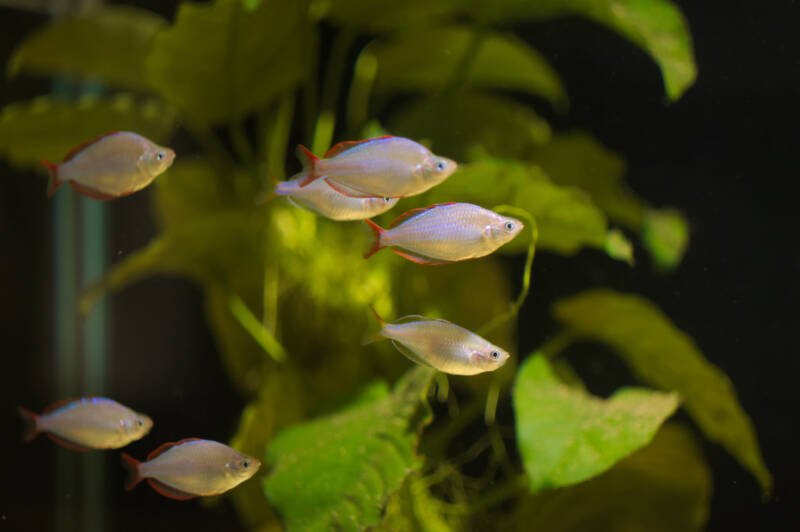
Minimum Tank Size: 20 gallons
The dwarf neon rainbow is striking, with brilliant blue scales and bright red fins. This species is smart and highly interactive with its tank mates and owners.
These three-inch-long (7.6 cm) fish stick to the middle and upper water column levels.
They are most active when in a group of at least six.
Males can be aggressive during breeding, and a good-sized group with an even number of males and females can help.
They are sensitive to shifts in water pH; however, their preferred range matches perfectly with your guppy’s.
Keep a reliable test kit on hand to stay within their range.
5. Harlequin Rasbora (Trigonostigma heteromorpha)

Minimum Tank Size: 10 gallons
Gentle nature, small size, and striking markings make the harlequin rasbora an easy guppy tank mate.
Endemic to southeast Asia, this schooling fish has a long lifespan.
This hardy fish can tolerate fluctuation in water conditions better than most species.
Their preferred conditions match the guppy’s quite well, and they share a love for a well-planted tank.
These rasboras are more likely to be the target of aggression than to be the ones causing it.
Keep them in a group of eight to 10 in a large tank with plenty of swimming and hiding space.
6. Endler’s Livebearers (Poecilia wingei)

Minimum Tank Size: 20 gallons
Found in only one natural location, Endler’s livebearers are a special species. These relatives of the guppy sport neon and metallic color blocks.
They come in numerous variations and readily breed in captivity, including with the guppy.
They reach two inches (5 cm) in length, are quite active, and get along well with other species.
Females can be territorial, but keeping a ratio of three females to every male should reduce aggression.
There is a narrow range where water hardness tolerance matches between the Endler’s and guppies’ (Endlers prefer hard water).
However, they match well in temperature and pH needs.
7. Dwarf Chain Loach (Yasuhikotakia sidthimunki)

Minimum Tank Size: 20 gallons
Dwarf loaches are excellent bottom dwellers to pair with your guppy as the two species will not compete for space.
These fish stay in the two-inch range (5 cm), so their adult size is also compatible with the guppy.
Introduce dwarf loaches in groups of at least three, so they can have a comfortable shoal. Include plenty of plants and a sandy bottom.
They spend most of their time along the bottom but explore the middle regions as well.
Peaceful in nature, these fish do not nip at fins and so would not give your guppies trouble.
8. White Cloud Mountain Minnow (Tanichthys albonubes)

Minimum Tank Size: 10 gallons
The White Cloud Mountain minnow’s small adult size of 1.5 inches (4 cm) pairs well with your guppy.
This native of cool mountain streams is prized for its beautiful colors and less intensive care requirements.
White Clouds maintain a peaceful shoal and need a group of at least six.
Take care to ensure both species are accustomed to similar water parameters.
The White Cloud does best at cool temperatures between 64-72°F (18-22°C), never higher than 80°F (26.6°C).
The guppy has a wide range of tolerance, but compatibility depends on the temperature to which they are accustomed.
9. Mollies (Poecilia spp.)

Minimum Tank Size: 10 gallons
Mollies are another easy-to-care-for, popular species. They have an extensive natural range and inhabit slow-moving waterways.
Due to extensive cross-breeding, there are numerous color variations.
This peaceful fish reaches 4.5 inches (11 cm) in length. Matching water parameters for your guppy and molly requires some attention.
While temperature needs to match well, keep the pH on the low side of the molly’s range.
Also, the molly prefers very hard water to the guppy’s moderate.
The number of female mollies in a group should exceed the number of males. Keep a group of at least four to allow them to shoal.
10. Rummy Nose Tetra (Hemigrammus rhodostomus)

Minimum Tank Size: 20 gallons
The rummy nose tetra is another peaceful Amazon River species.
With translucent bodies, bright red heads, and zebra-striped tails, this fish brings a unique flash of color.
Their small adult length of 2.5 inches (6 cm) pairs well with the guppy’s size. The rummy nose prefers to shoal in a group of at least six and gets along well with other gentle species.
These fish prefer water a little warmer and softer than the guppy, but their tolerance ranges overlap adequately.
The rummy nose is not picky when it comes to tank decorations but needs a good-sized area to swim.
11. Otocinclus (genus)
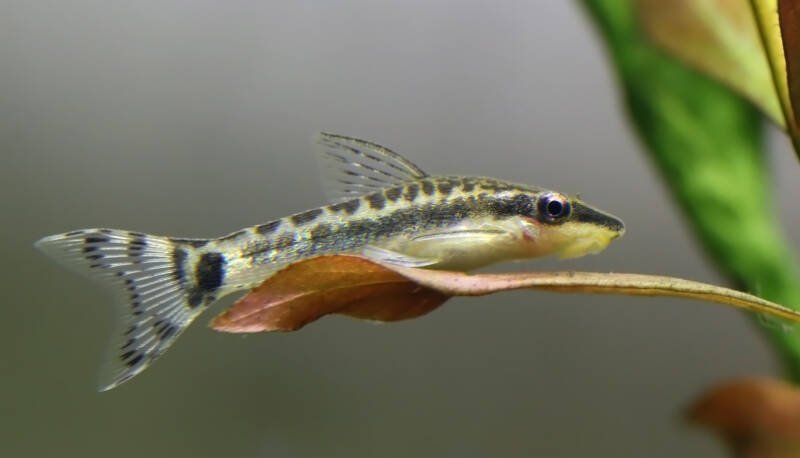
Minimum Tank Size: 10 gallons
Genus otocinclus includes 20 species of dwarf suckerfish. These are the ultimate, low-maintenance fish with the benefit of keeping your tank clean.
They are so gentle and passive, they are recommended for most community tanks, guppies included.
Otos do not grow more than 2 inches (5 cm) in length, tolerate water condition fluctuations, and love the same conditions as your guppy.
These bottom dwellers stay out of the guppy’s levels, and as armored catfish, they have extra protection from inquisitive fish.
Otos like to be in schools of four to six and need a safe place to hide if threatened.
12. Nerite Snails (Neritina natalensis)
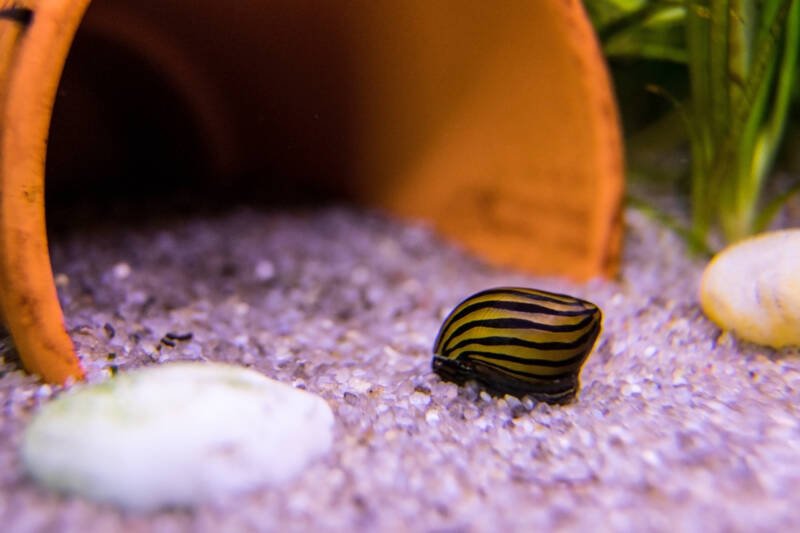
Minimum Tank Size: 10 gallons
Nerite snails are small algae eaters that are common in nature. As a result, there are numerous varieties and color variations available.
They make busy and active additions to a cleanup crew, preferring a tank with sandy substrate and plenty of rocks.
This gentle species grows to around 1 inch (2.5 cm) and pretty much keeps to itself, looking for food along the tank bottom.
Their preferred water temperature and hardness match well with your guppy’s but make sure you keep the pH level in the range where their conditions overlap. A good test kit can help you here.
13. Kuhli Loach (Pangio kuhlii)
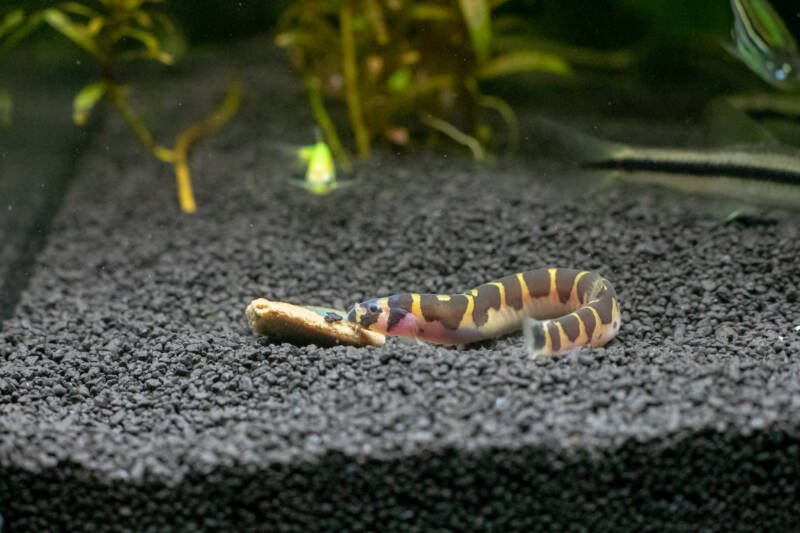
Minimum Tank Size: 15 gallons
The kuhli loach is a small, eel-shaped fish from Southeast Asia.
This species pairs well with the guppy, reaching between 3 to 5 inches (13 cm) in length.
They mind their own business on the tank bottom, quietly hiding during the day and scavenging at night.
Kuhli loaches eat leftover food and are valuable members of a cleanup crew. They are shy and will not provoke your guppies.
Keep them in a group of at least three to increase their comfort level.
Remember that kuhli loaches have thin scales and are susceptible to disease if the water quality is not adequate.
14. Swordtail Fish (Xiphophorus helleri)
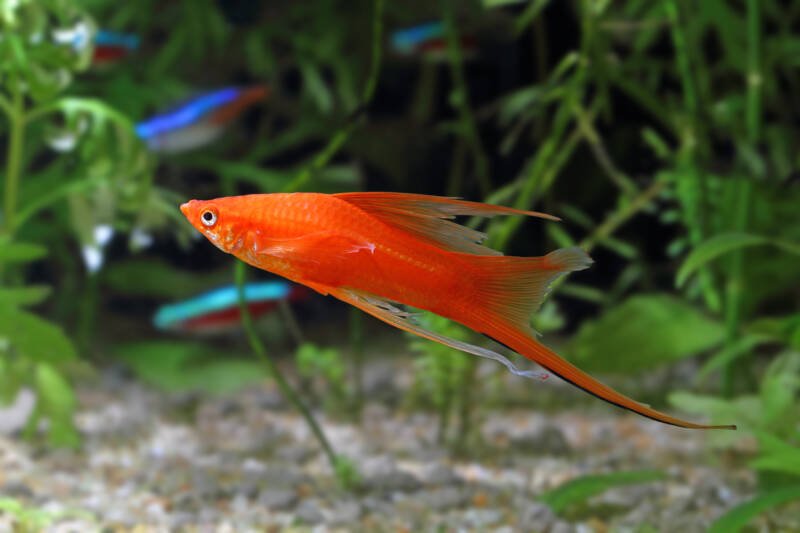
Minimum Tank Size: 15 gallons for a single fish
The swordtail brings bright red color and sleek, elongated fins. Native to North and Central America, they are a live-bearing, simple-to-care-for species.
They grow a bit larger than your guppy, reaching a length of 5.5 inches (14 cm).
These fish favor similar water conditions as your guppy but keep the hardness toward the lower end of the swordtail’s range. Include a good amount of vegetation in the tank.
Swordtails do not typically shoal but enjoy the company of others of their species.
Males can be territorial, so keep a ratio of four females to one male to keep aggression down.
15. Chili Rasbora (Boraras brigittae)

Minimum Tank Size: 5 gallons
Bright red color and oversized eyes make the chili rasbora endearing. This active fish reaches only 0.6 to 0.8 inches (1.5-2 cm) in length.
They look spectacular in a school and need six or more to be comfortable.
This type of rasboras occupy all levels of the tank, and their peaceful nature makes them a great match for your guppy.
Matching water parameters requires attention. The chili rasbora prefers softer water than the guppy.
In addition, the rasbora’s natural waters are far more acidic, and the best area of overlap is a neutral pH, which is the upper end of the rasbora’s tolerance.
16. Sparkling Gourami (Trichopsis pumila)

Minimum Tank Size: 15 gallons
Sparkling gouramis have colorful bodies with delicate, spotted fins and love still, warm waters.
They reach 1.5 inches (3.8 cm) in length, are incredibly easy to care for, and tolerate a wide range of water conditions.
They spend their time in the top half of the tank, coming to the surface for air and using their labyrinth organ to get oxygen.
Some high and low growing plants in the tank will benefit both the gourami and guppy as hiding spaces.
If you are planning to breed your guppies, set up a separate breeding tank as gouramis may eat the fry.
17. Shrimp
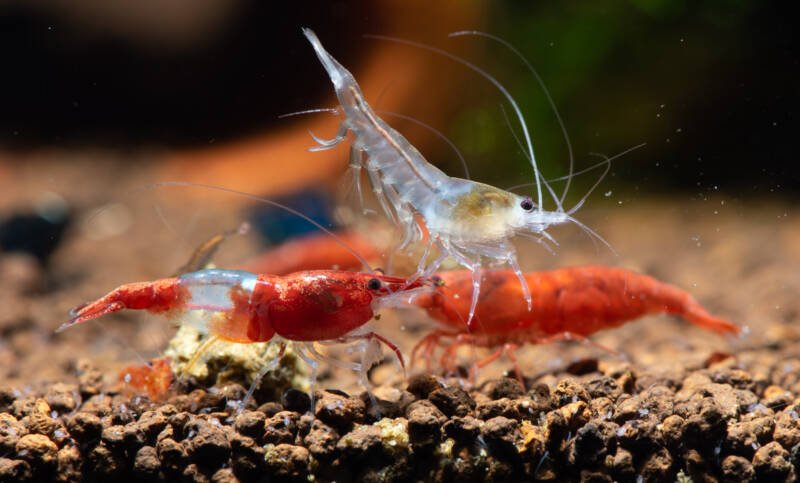
Minimum Tank Size: 5 gallons
The benefit of pairing your guppy with shrimp is two-fold. First, shrimp occupy the bottom level of the water column and thus will stay out of your guppy’s way.
Second, they are excellent members of your tank cleanup crew as they happily munch along the bottom of the tank.
Cherry shrimp and ghost shrimp are popular choices, and either would work well with your guppy.
Both are hardy, easy-going, and their temperament is excellent for a community tank.
Be careful when introducing cherry shrimp. If they are still small, your guppy may try to eat them.
18. Honey Gourami (Trichogaster chuna)
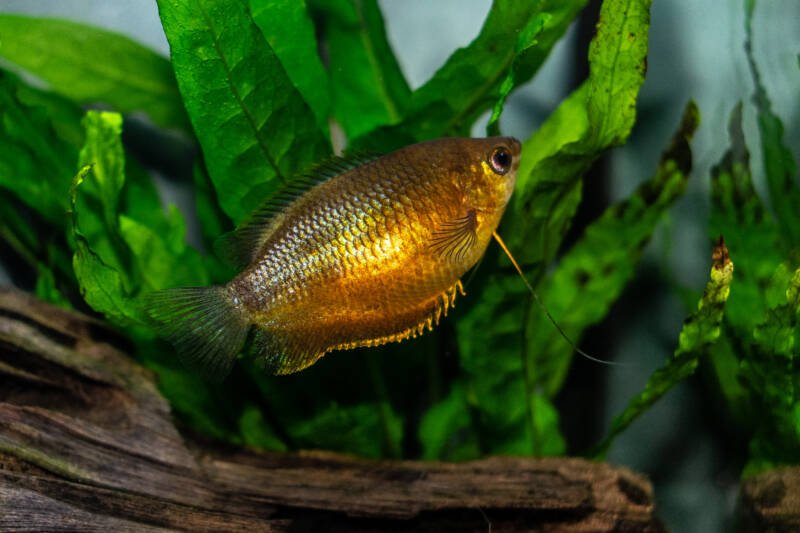
Minimum Tank Size: 10 gallons
The honey gourami is a shy and gentle species. Known for its soft yellow color and pointed dorsal fins, this hardy fish is best kept in a group of four to six in a tank with plenty of live aquatic plants.
Once they are comfortable, they swim in all areas of the tank.
They reach an adult length of 2 inches (5 cm). While some hierarchical aggression can occur, it does not typically extend to other species in the tank.
Honey gouramis pair well with guppies due to the similarity in their water requirements and the excellent matching of their temperaments.
19. Zebra Danio (Danio rerio)

Minimum Tank Size: 10 gallons
The zebra danio takes its name from its long, horizontal stripes. This native of India and Bangladesh is mostly captive-bred and reaches 2 inches (5 cm) in length.
These fast-swimming, active fish occupy all tank levels and are often used as dither fish (their high activity levels may annoy your guppies).
They have a narrow temperature and pH tolerance but are well within the guppy’s range.
This species cannot be kept on its own and needs a group of at least five.
Keep an eye out for fin nipping, as your guppy may present a tempting target.
20. Platies (Xiphophorus spp.)

Minimum Tank Size: 10 gallons
Platies are small, colorful fish popular in the aquarium trade for their peaceful nature, colorful varieties, and high activity levels.
They are hardy and belong to the same family as guppies.
These fish come from slow-moving, warm waterways in Central America.
Their preferred water conditions match the guppy’s well but keep the hardness on the lower end of the platy’s range.
Platies do not shoal but are most comfortable when kept in a group.
Keep a ratio of two or three females for every male. Males occasionally squabble, but aggression does not extend to other tank mates.
What to Put in a Tank with Guppy Fry?
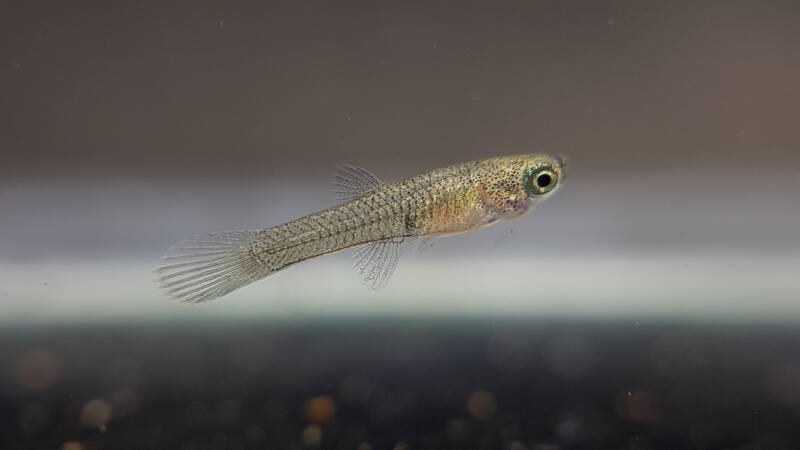
If you keep male and female guppies together, you know that a brood of little ones is just a matter of time.
The following species are too slow to hunt down the guppy fry but will readily consume any that do not survive.
Decaying fry in the tank can adversely affect your water quality, so it is a good idea to have species to help keep things clean.
1. Amano Shrimp (Caridina multidentata)
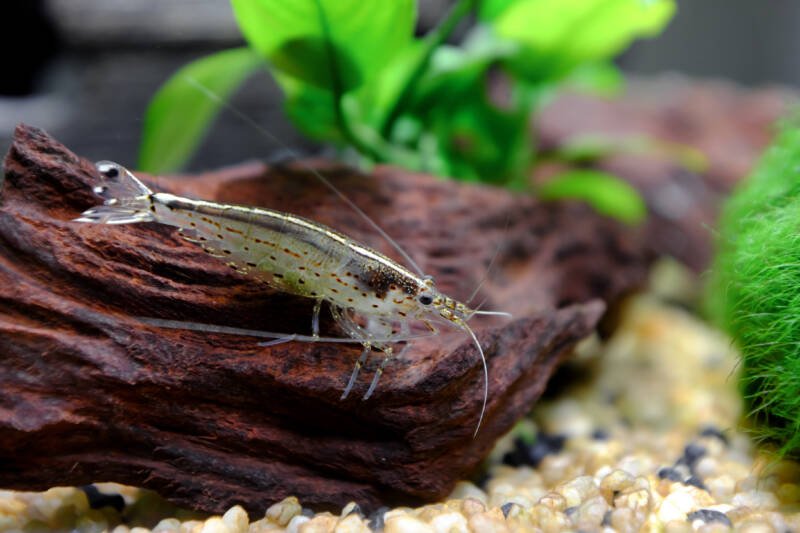
Minimum Tank Size: 10 gallons
This “dwarf” shrimp is native to Asia and grows to an adult length of two inches (5 cm).
They spend most of their time on the tank bottom looking for uneaten foods and also consume nuisance algae.
Amanos are peaceful in nature and will get along with your guppies. Provide adequate plant cover in the tank to give them a safe place to molt.
2. Pond Snail (Lymnaea stagnalis)
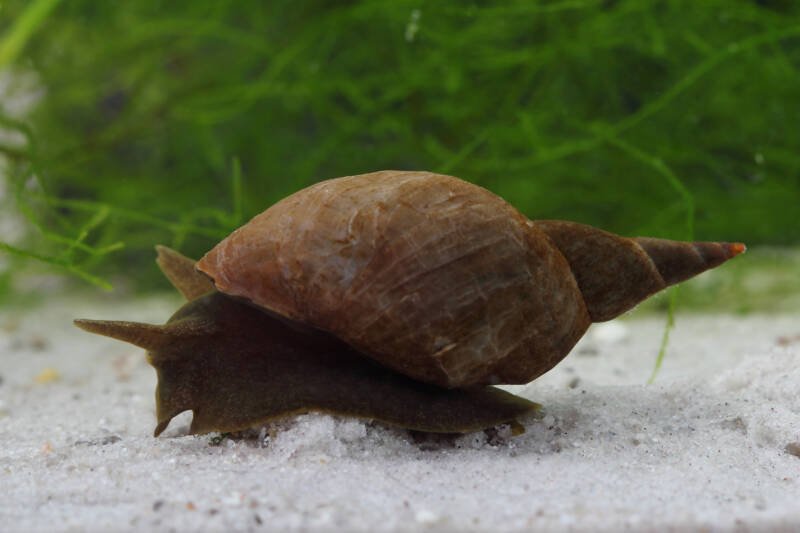
Minimum Tank Size: 5 gallons
The pond snail is considered a nuisance snail due to its rapid reproduction.
However, detritus is their primary food source, and they are excellent consumers.
Their pointed shell grows to three inches in length (7.6 cm), and they have a trap door, or operculum, which provides protection.
This species survives in a huge range of water temperatures, pH levels, and hardness.
They are challenging when it comes to ridding the tank of them, but in controlled numbers, they can be helpful.
3. Red Tropical Crab (Perisesarma bidens)

Minimum Tank Size: 10 gallons
Although the red tropical crab can grab a sick or injured fish, it is on the slow side and sticks primarily to scavenging.
It pairs well with species that stick to other levels of the water column, such as the guppy.
The biggest challenges with this species and your guppy would be water parameters and tank setup.
This crab lives in mangroves and needs both aquatic and land features. They favor slightly brackish water, but guppies can also thrive in water with the same salinity.
Make sure you have a tight-fitting lid on your tank, as these crabs can easily climb out.
Closing Thoughts
As you can see by the length of our list, there are many choices when it comes to finding a tank mate for your guppy.
Keep in mind the small size of the guppy and its need to pair with other peaceful species, and you should have no trouble finding a great match.
Drop us a message! Tell us your favorite guppy tank mates!